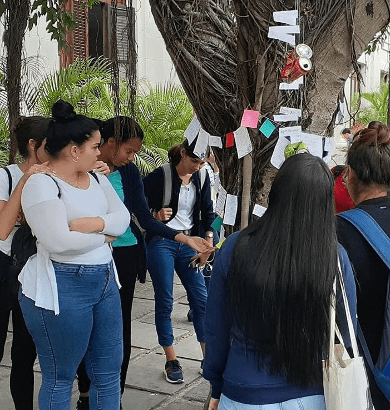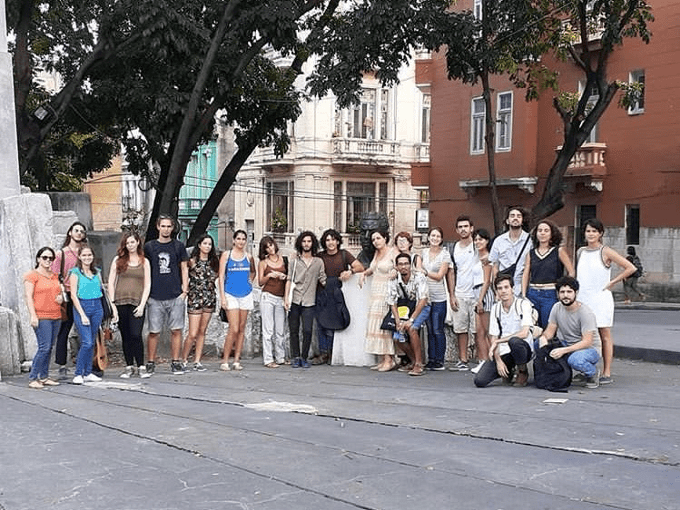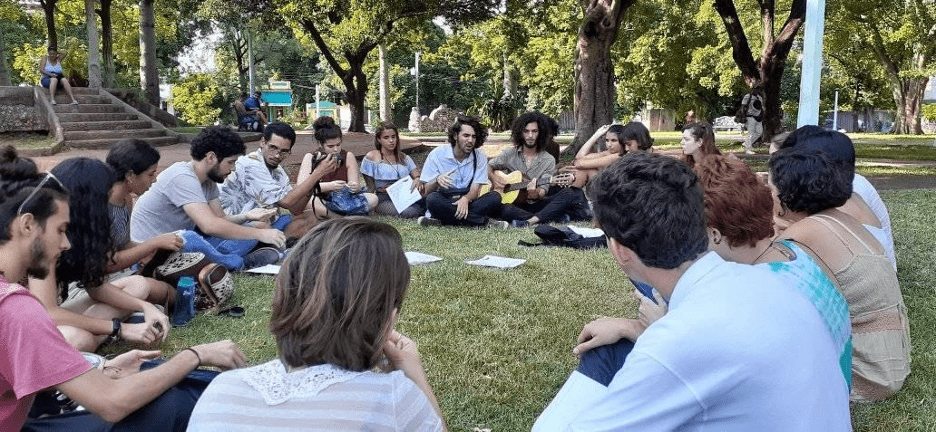
About the Author
Gabriela Rivero is a senior at Harvard College studying Sociology with a secondary in Latinx Studies. She loves writing, talking and traveling, which is why she’s so grateful to have been able to study abroad in the CASA program in Cuba—land of her grandparents—and have so many interesting experiences. Next year, Gabriela plans on going to law school to become an immigration attorney.
Acerca del Autor
Gabriela Rivero está en su último año en Harvard College estudiando Sociología con un segundo certificado en Estudios Latinos. Le encanta escribir, hablar y viajar, razón por la cual está tan agradecida de haber podido estudiar en el extranjero a través del programa CASA en Cuba—tierra de sus abuelos—y de haber tenido tantas experiencias interesantes. El año que viene, Gabriela planea asistir a escuela de derechos para convertirse en abogada de inmigración.
Bringing Art to Campus with Revista Creativa Manifiesto
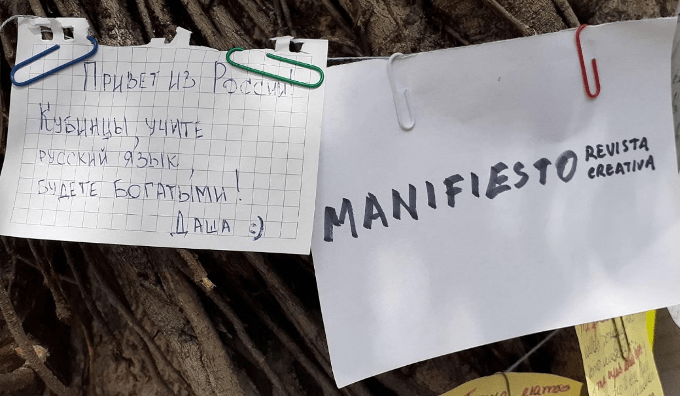
A poem by a Russian contributor and a sign for the magazine at Manifiesto’s Poem Tree event at the University of Havana. All photo credits to Revista Creativa Manifiesto
Cuba is an artsy place. While studying in Havana in the fall of 2018, it was impossible for me to go anywhere without stumbling across street performers, murals, plays or concerts, a veritable explosion of culture on the island. Back home, I had considered myself something of an artist, dabbling in creative writing and music; however, being surrounded by such an abundance of creativity certainly felt intimidating.
That’s why last year, when my friends and classmates Hamed Toledo and Alejandro Suárez Placeres decided to start an online literary magazine at the University of Havana, they were grateful for their familiarity with the Cuban arts scene. Hamed had editorial experience running Ca(u)sa, a magazine he started to renew interest in the history and culture of his hometown of Guanabacoa, while Alejandro was an avid participant in literary workshops in the town of Caimito in Artemisa, where his mother had served as Municipal Director of Culture for three years.
When I befriended them in their junior year, Hamed and Alejandro had known each other already for two years, meeting as first-year philosophy majors and belonging to the self-described “artsy” group on campus. They participated year-round in artistic events in their hometowns as well as at the National Union of Writers and Artists of Cuba (UNEAC) in Havana during the school year, where I once watched them recite poetry and perform an epic cover of “Sweet Home La Habana.” I had already returned to the States when Alejandro told me their plans to start Manifiesto. I asked him what had sparked the decision to start a literary magazine when both young men and our other friends were already so involved in the arts. He immediately pointed to the lack of a university space where students were free to display their creative talents, and I was suddenly aware of the fact that I hadn’t seen a single poster or poem at the University of Havana the entire time I had been abroad.
“The idea of Manifiesto was just that,” said Alejandro, “to be a space for university creativity and socializing.”
Since the first edition launched in March 2019–put together by just Alejandro, Hamed, and three more of our friends–Manifiesto has grown and evolved into a veritable artistic movement. It now boasts staff, contributors and readers from across the university and from the general public; a podcast (featuring an episode where yours truly reads an original poem in Spanish); and multiple social media platforms where followers can keep up with the publication’s news and exchange ideas. This digital community has transcended national borders and allowed for collaboration from multiple countries, including Mexico, the United States, Argentina and Chile. Back in Havana, Manifiesto also periodically hosts live events featuring recitations, raps and musical performances by contributors, moving beyond the literary to encompass any kind of creative work.
“We had an event at the Facultad de Filosofía at the UH where we strung up poems around a tree,” Hamed told me, describing one of Manifiesto’s most recent public events. “The intention was to bring poetry to that space and entice people to leave their own poems, as well.”

Students read and exchange poems at Manifiesto’s “Poem Tree” at the Facultad de Filosofía, Historia y Sociología at the University of Havana
As evidenced by the group’s Instagram, the event was an incredible success, with so many people adding to the collection that they had to co-opt two more trees. In an excited text over Facebook Messenger just a few days after the event, Alejandro described how even non-university affiliates participated, and the display ultimately stayed up for a week as poems continued to accumulate. Manifiesto has also hosted an open mic night at tattoo-parlor-turned-event-venue La Marca (before celebrities like Haydée Milanés discovered the space, I might add), as well as launch parties known as “Manifiestas” for the second and third issues. The Manifiesta to celebrate the third issue was perhaps one of the most memorable, featuring a “pilgrimage” from the Monument to Mella in front of the University to a park a few blocks down, where participants passed around a guitar, read their contributions to the new edition and enjoyed tea and cookies.
However, getting Manifiesto off the ground—and especially keeping it there—has been no easy feat. Editing and layout are done on old, slow computers, and solicitation for submissions, communication between staff, and materials for each issue are sent via Whatsapp with limited data and wifi. I still remember receiving a text from Hamed asking if I would be willing to print a few hard copies of the latest issue to bring with me when I next visited, to be shared among the entire group of contributors and readers. The only reason they’d managed to print any hard copies before that was due to the generosity of Manifiesto’s readers and other friends abroad.
“In Cuba, starting an independent project presupposes a lot of challenges,” says María Fernanda Abelló, a second-year sociology major and one of Manifiesto’s editors. “We’re part of a history of many projects that have died in the intent to become institutionalized. We’re constantly fighting for our autonomy and have until now managed to stay afloat, but not by luck.”
Unfortunately, that fight hasn’t just been to conquer technological limitations and the difficult work-school balance that comes with being a Manifiesto staff member. Manifesto and its participants have faced immense pushback from university administrators, something that seems surprising to me in a country that’s traditionally expressed ardent support for the arts. However, anyone familiar with the aftermath of the Revolution knows that censorship previously went hand-in-hand with artistic expression in Cuba. While less common today, institutional actors (including university leaders) are sometimes still skeptical of new projects like Manifiesto, fearing subversion.
“After many attempts at passively enriching the usual cultural activities on campus, we were expelled in the middle of the first Manifiesta at the Facultad de Filosofía,” María Fernanda recounted. “That was the first real threat against the group. Since then we’ve been dodging rocks…when the dean threw us out of the park, he said: ‘The university isn’t for the students, the students are for the university.’ What academic institution can survive without pupils ready to create?”
Manifiesto members told me that artistic expression is a social imperative, which is why being barred from using university spaces for their events hasn’t stopped them from giving students a creative voice off campus.
“Art, literature, they’re pieces of truth, of what we feel…Where there are people there is art,” Alejandro said. “It’s a universal way of saying we exist.”
“Manifiesto’s successes have been triumphs not just for us personally, but also for the university community that for so long has been deprived of an independent cultural space,” Hamed agreed. “Despite the obstacles, we’ve forged ahead and garnered the support and recognition of not just the students, but also other organizations that have publicized the efforts and the mission of our project.”
In the future, the Manifiesto team hopes to release a few special issues focusing on photography and illustrations, as well as continue with the normal literary publication and podcast. It seems like the technological situation may be improving as well, based on Alejandro’s series of Photoshopped (rather than hand-drawn) covers for the next few issues. Other than that, the team has no solid plans and is open to whatever the muses–and Manifiesto community–propose.
“What will Manifiesto be tomorrow?” Hamed asks. “I don’t know, and I don’t think anyone does. Manifiesto is a seed, and that maybe implies that one day it will cease to exist, which would be welcome news if in its place sprouted many more projects and ideas…with that, at least, I would be satisfied.”
Trayendo el arte de vuelta al campus con Revista Creativa Manifiesto
Por Gabriela Rivero

Un poema por un contribuidor ruso y un anuncio para la revista en el evento Árbol de Poemas de Manifiesto en la Universidad de La Habana. Créditos fotográficos de Revista Creativa Manifiesto
Cuba es un lugar artístico. Mientras estudiaba en La Habana durante el otoño del 2018, era imposible para mí viajar sin tropezar con artistas callejeros, murales, obras de teatro o conciertos, una verdadera explosión de cultura en la isla. En los Estados Unidos, me había considerado media artista, experimentando con la escritura creativa y la música; sin embargo, estar rodeada por tal abundancia de creatividad definitivamente sintió intimidante.
Por eso, cuando el año pasado mis amigos y compañeros de clase Hamed Toledo y Alejandro Suárez Placeres decidieron empezar una revista literaria en línea—Revista Creativa Manifiesto—en la Universidad de la Habana, estaban agradecidos por su conocimiento del ambiente artístico en Cuba. Hamed tenía experiencia como editor manejando Ca(u)sa, una revista que había empezado para renovar el interés en la historia y la cultura de su pueblo nativo de Guanabacoa, mientras Alejandro era participante ávido en talleres literarios del pueblo de Caimito en Artemisa, donde su madre había sido Directora Municipal de Cultura por tres años.
Cuando me volví su amiga en su tercer año, Hamed y Alejandro ya se habían conocido dos años atrás como estudiantes de filosofía de primer año de universidad, formando parte del autodescrito grupo “artístico” del campus. Participaban todo el año en eventos artísticos en sus pueblos nativos además de en la Unión Nacional de Escritores y Artistas de Cuba (UNEAC) en la Habana durante el año escolar, donde una vez los vi recitar poesía y cantar una versión épica de “Sweet Home La Habana.” Ya había regresado a EE.UU. cuando Alejandro me contó de sus planes para empezar Manifiesto. Le pregunté qué había inspirado la decisión de empezar una revista literaria cuando ambos jóvenes y nuestros otros amigos ya estaban tan involucrados en las artes. Inmediatamente destacó la falta de un espacio universitario donde estudiantes estaban libres de mostrar sus talentos creativos, y de repente me di cuenta que no había visto ningún afiche ni poema en la Universidad de La Habana el semestre entero que pasé en el extranjero.
“La idea de Manifiesto era precisamente esa,” dijo Alejandro, “ser un espacio para la creatividad y socialización universitaria.”
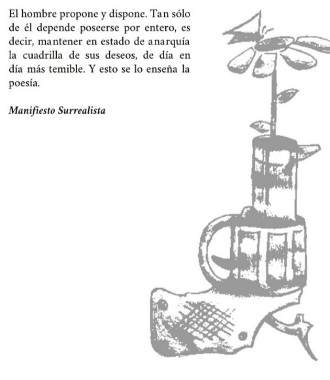
Un extracto del segundo número de Manifiesto, con una ilustración por Alejandro Suárez Placeres
Desde el lanzamiento del primer número en marzo del 2019—organizado por solamente Alejandro, Hamed y tres más de nuestros amigos–Manifiesto ha crecido y evolucionado para formar un verdadero movimiento artístico. Ahora cuenta con personal, contribuidores y lectores de toda la universidad y del público general; un podcast (con un episodio en que esta autora lee un poema original en español); y múltiples plataformas en las redes sociales donde seguidores pueden mantenerse al tanto de las noticias de la publicación y compartir ideas. Esta comunidad digital ha trascendido fronteras nacionales y permitido la colaboración de varios países, incluyendo a México, los Estados Unidos, Argentina y Chile. En La Habana, Manifiesto también periódicamente organiza eventos en vivo con recitaciones, raps y música hecho por contribuidores, yendo más allá de lo literario para incluir cualquier tipo de obra creativa.
“Tuvimos un evento en la Facultad de Filosofía en la UH donde colgamos poemas alrededor de un árbol,” me contó Hamed, describiendo uno de los eventos públicos más recientes de Manifiesto. “La intención era traer poesía a ese espacio y embullar a la gente dejar sus propios poemas también.”
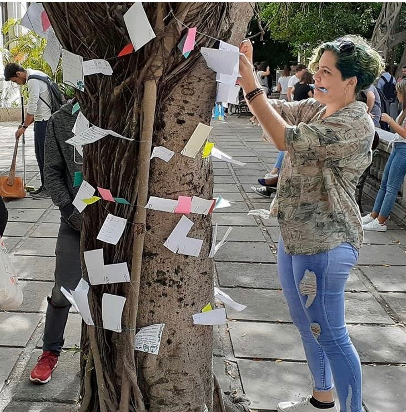
Estudiantes leen e intercambian poemas en el “Árbol de Poemas” de Manifiesto en la Facultad de Filosofía, Historia y Sociología de la Universidad de La Habana
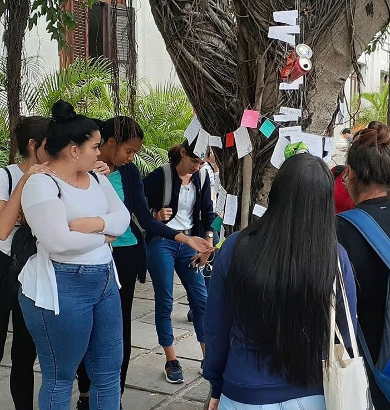
Evidenciado por la cuenta de Instagram del grupo, el evento era todo un éxito, con tantos participantes añadiendo a la colección que había que cooptar dos árboles más. En un mensaje emocionado por Facebook Messenger unos días después del evento, Alejandro me describió cómo incluso personas no-afiliadas con la universidad participaron, y la exhibición ultimadamente se quedó por una semana mientras seguían acumulando los poemas. Manifiesto también ha organizado una noche de micrófono abierto en el salón-de-tatuajes-vuelto-sala-de-eventos La Marca (antes que famosos como Haydée Milanés descubrieran el espacio, quisiera destacar), además de fiestas de lanzamiento conocidos como “Manifiestas” para el segundo y tercer número. La Manifiesta para celebrar el tercer número era quizás uno de los más memorables, con un “peregrinaje” del Monumento a Mella frente la Universidad hasta un parque que quedaba a unas cuadras, donde participantes pasaron una guitarra, leyeron sus contribuciones al nuevo número y disfrutaron té y galletas.
Sin embargo, empezando Manifiesto de la nada y levantandola a una alta calidad—y especialmente manteniéndolo ahí—no ha sido fácil. Editación y diseño están hechos en computadoras viejas y lentas, y solicitudes de contribuciones, comunicación entre personal y materiales para cada número están enviados por Whatsapp con datos y WiFi limitados. Todavía recuerdo recibiendo un mensaje de Hamed preguntándome si estaría dispuesta de imprimir unas cuantas copias duras del número más reciente para traer conmigo cuando próximo visitara, para compartirlas con el grupo entero de contribuidores y lectores. La única razón que habían logrado imprimir copias duras antes era gracias a la generosidad de los lectores de Manifiesto y de otros amigos en el extranjero.
“En Cuba, empezar un proyecto independiente presupone muchos desafíos,” dice María Fernanda Abelló, un estudiante de segundo año de sociología y una de los editores de Manifiesto. “Somos parte de una historia de muchos proyectos que se han muerto en el intento de institucionalizarse. Estamos constantemente luchando por nuestra autonomía y hasta ahora hemos logrado mantenernos a flote, pero no por suerte.”
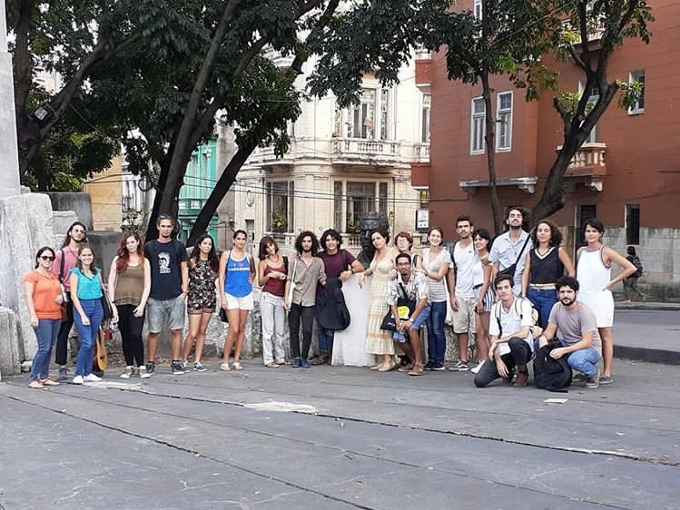
Miembros de la comunidad Manifiesto empezando su peregrinaje desde el Monumento a Mella
Desafortunadamente, la lucha no ha sido solamente para conquistar las limitaciones tecnológicas y la balance trabajo-escuela que acompaña ser miembro del personal de Manifiesto. Manifiesto y sus participantes se han enfrentado con resistencia inmensa por parte de administradores universitarios, algo que me resultó sorprendente en un país que tradicionalmente ha expresado apoyo ardiente por las artes. Sin embargo, cualquier que conoce las repercusiones de la Revolución sabe que la censura antes iba mano en mano con la expresión artística en Cuba. Aunque es menos común hoy en día, actores institucionales (incluyendo líderes universitarios) a veces todavía son sospechosos de proyectos nuevos como Manifiesto, temiendo la subversión.
“Después de muchos intentos de pasivamente enriquecer las actividades culturales usuales del campus, estuvimos expulsados en medio de la primera Manifiesta en la Facultad de Filosofía,” María Fernanda, una estudiante, recordó. “Esa era la primera amenaza real contra el grupo. Desde entonces hemos estado esquivando piedras…cuando el decano nos botó del parque, dijo: ‘La universidad no es para los estudiantes, los estudiantes son para la universidad.’ ¿Qué institución académica puede sobrevivir sin alumnos listos para crear?”
Miembros de Manifiesto me dijeron que la expresión artística es un imperativo social, razón por la cual estar prohibidos usar espacios universitarios para sus eventos no les ha detenido en su misión de dar a los estudiantes una voz creativa fuera del campus.
“El arte, la literatura, son pedazos de la verdad, de lo que sentimos…Donde haya gente hay arte,” me contó Alejandro. “Es una manera universal de decir que existimos.”
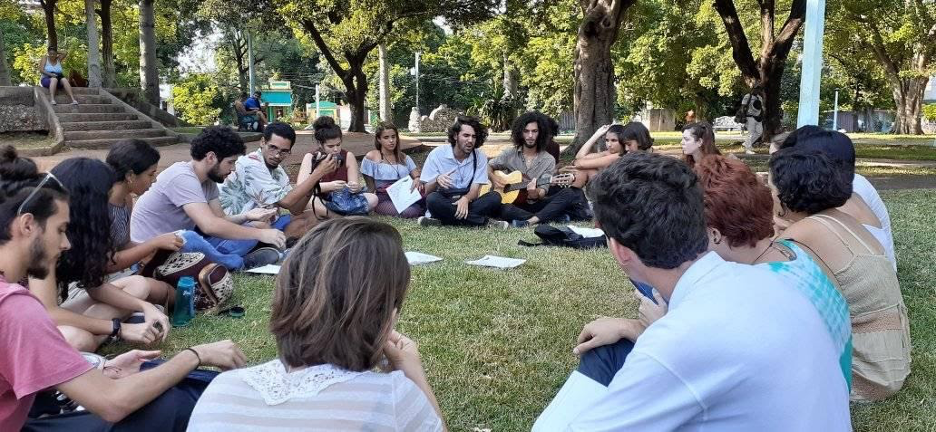
Una Manifiesta en el parque de H y 21
“Los éxitos de Manifiesto han sido triunfos no solamente para nosotros a nivel personal, sino también para la comunidad universitaria que por tanto tiempo se ha visto privado de un espacio cultural independiente,” Hamed añadió. “A pesar de los obstáculos, hemos seguido adelante y contamos con el apoyo y reconocimiento de no solamente los estudiantes, sino también otras organizaciones que han publicado nuestros esfuerzos y la misión de nuestro proyecto.”
En el futuro, el equipo Manifiesto espera sacar unos números especiales enfocados en la fotografía y la ilustración, además de continuar con la publicación literaria normal y el podcast. Parece que la situación tecnológica puede estar mejorando también, basado en la serie de portadas hechas por Photoshop (en vez de dibujadas a mano) de Alejandro para los próximos números. Además de eso, el equipo no tiene ningún plan fijo y está receptivo a cualquier cosa que las musas—y la comunidad Manifiesto—proponen.
“¿Qué será Manifiesto mañana?” pregunta Hamed. “No lo sé, y no creo que nadie sabe. Manifiesto es una semilla, y eso quizás implica que algún día dejará de existir, pero esto sería noticia bienvenida si en su lugar floreciera muchos proyectos e ideas más…con eso, por lo menos, yo estaría satisfecho.”
More Student Views
Of Salamanders and Spirits
I probably could’ve chosen a better day to visit the CIIDIR-IPN for the first time. It was the last week of September and the city had come to a full stop. Citizens barricaded the streets with tarps and plastic chairs, and protest banners covered the walls of the Edificio de Gobierno del Estado de Oaxaca, all demanding fair wages for the state’s educators. It was my first (but certainly not my last) encounter with the fierce political activism that Oaxaca is known for.
Public Universities in Peru
Visits to two public universities in Peru over the last two summers helped deepen my understanding of the system and explore some ideas for my own research. The first summer, I began visiting the National University of San Marcos (UNMSM) to learn about historical admissions processes and search for lists of applicants and admitted students. I wanted to identify those students and follow their educational, professional and political trajectories at one of the country’s most important universities. In the summer of 2025, I once again visited UNMSM in Lima and traveled to Cusco to visit the National University of San Antonio Abad del Cusco (UNSAAC). This time, I conducted interviews with professors and student representatives to learn about their experiences and perspectives on higher-education policies such as faculty salary reforms and the processes for the hiring and promotion of professors.
Post-Secondary Education Access in Peru
Over the summer, I visited four public schools in Peru located in two regions, about 1,200 miles apart from each other. I interviewed teachers, principals and high school juniors and seniors. I wanted to discover their perspectives on perceived opportunities and barriers for students to plan for and fulfill their higher education goals. I also interviewed the superintendent at each school district to learn about local initiatives aimed at decreasing barriers to higher education transition.


